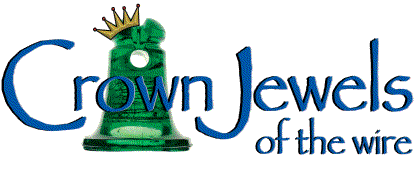Color Them Pretty
by Alan Rodgers
Reprinted from "INSULATORS - Crown Jewels of the Wire", November 1974, page 8
At a recent flea market, a woman approached my table where I had a variety of
insulators for sale. She looked over my "ware" as if she was an
experienced collector. Then she picked up the only sun colored purple insulator
I had and remarked, "You sure know how to color these up pretty." This
brings to mind that recently very little has been written about the glass that
insulators are made of. As in this case, S.C.A. (sun colored amethyst) is the
term collectors have applied. The authenticity of this glass is known to all
collectors, but not too much has been said recently about what the glass is made
of.
The basic composition of glass is soda ash, lime, limestone, and potash. From
these are derived aqua or green insulator glass. Generally, the darker the aqua,
the greater the quantity of iron and other impurities that have been mixed in
the sand. It has been thought that the darker the color, the more iron it
contained; thus, the stronger the glass. This dark color was fine for some
customers, but others were more fussy and wanted more inconspicuous decolorized
insulators, uniform in color. Manganese, a chemical when used in small
quantities, produced a clear glass. "When used in large amounts manganese
produces the amethysts, purples, and even black colors in glass." These
dark colors are widely seen in several Canadian styles. On the other hand, some
individuals have claimed that these dark colors were that way long before they
were placed in service on a pole, and never affected by the sun. Manganese was a
cheap way to decolorize cheap glass, but also very unstable. Its use is reported
to have been discontinued around 1916 - 1918. It has been said that World War I
cut off the supply of manganese from Germany. However, if World War I lasted
from 1914 to 1918, whereas the well known Whitall Tatum Company was producing
insulators from 1920 to 1938, how was it possible for so many thousands of SCA
number one style to have been made? Strangely, in 1945 - 1946 , Hemingray
produced the 54 A & B transposition in SCA. This was many years after the
supposedly end of the use of manganese. Actually the war may have eliminated
much use of manganese, but it continued until the development of the
"continuous tank furnaces for making large quantities of glass became
popular by glass companies". Then manganese became unpopular and too
unstable for large batches.
Selenium later replaced manganese as a stable decolorizer. However, too much
selenium produces pink colors, and in larger quantities, red glass can be
produced. Gold can also produce red glass. Alfonso, the chemical cobalt can
produce clear glass and a nice blue color in greater amounts. Combinations of
different chemicals, cullet glass (glass and old bottles melted down to help form
good glass). the way it was made, and even the firing temperature, make a
difference in color of glass. Interesting reading can be further obtained from
Sun Colored Glass by Mary J. Zimmerman and Insulators ... Just Insulators by
Frank Saccoman.
Obviously, sun colored glass is glass that is colored by the sun. Or more exactly, ultraviolet rays from the sun interact with the manganese in the glass.
The undesired color of the iron oxide present was being nullified by the
manganese. This produces clear glass only because of an unfinished chemical
process. Ultraviolet rays complete the process, thus producing the amethyst
shades. The color was dependent on how much manganese was in the glass and how
much sunlight it received. I have had many Tatum #1's from the Pacific Northwest
in a light SCA. One summer on the roof of my house under the blaring Florida sun
sure made a difference in some. Some folks have made "purple boxes"
which use a germicidal lamp to produce UV rays instead of the sun. This lamp is
very powerful and can accomplish what the sun can do in years, in a matter of
months. It is also dangerous and can blind, so I do not fool with it. Some
people use it for bottles or other glass, while others consider it cheating. I
have seen some nice deep colored items come out of purple boxes, but generally
the insulator will turn "all it is going to turn" up on top of the
pole.
Along with artificially changing the SCA is heating it. Heat turns SCA glass
back to its original near clear color. UV rays then can be applied to restore it
to purple again. This cycle can be continued indefinitely. It has been said that
some nice purple insulators have been put in a kiln and changed to a rare yellow
color (a phoney), nearly back to its original clear. These may be some of the
yellow California insulators. There are, however, sun colored amber insulators
changed like the purple. These may be some of the light yellow no name beehives?
A few suggestions if you want to try sunning. Do it outdoors, such as on a
roof, but not behind a window. The desert is a good place, but is not necessary,
as bottle collectors well know. Your house does not have to be in sunny
California, Arizona, or Florida. It can be anywhere there are many bright sunny
days. Try putting a few on the roof for a few summer months. Check the
difference. Some may change slightly, and others may have turned all they intend
to turn. Be careful and be patient, as some will take time.
|
